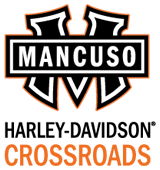Motorcycle Braking Guide
Motorcycle braking takes more skill than might be immediately obvious. Knowing when to use the front brake, when to use the rear brake, and what overall technique to use is complicated. That’s why the experts at Mancuso Harley-Davidson® Crossroads have created this list of motorcycle braking tips.
Apply The Brakes Based On The Situation
Motorcycles come with both a front brake and a rear brake. While the front brake is generally more powerful, both need to be used in concert in order to brake effectively and safely. Of course, how much each brake is used depends on the circumstances. In most cases, the front brake should do 70% of the work, with the rear brake doing the remaining 30%. If you need to make an emergency stop, that ratio will shift to be 90% on the front wheel and 10% on the rear wheel. Of course, using only the front brake can result in the rider being flung off if they’re not careful, so be smart about how you use your front and rear brakes.
Adjust Weight Accordingly
Since a motorcycle’s front brake is more powerful, a large percentage of both the bike’s weight and the rider’s weight should be pushed forward onto the front wheel and suspension. This will compress the front forks and push down on the front tire so that it has more contact with the road. This will result in a smoother, safer braking experience.
Avoid Locking Up The Rear Wheel
Of course, with all this weight being transferred to the front wheel, there’s a risk that the rear wheel will lock up if you over apply the brake. If your rear wheel does lock up, you’ll likely go into a skid. Keep your eyes up and your feet steady during a skid. If your bike is traveling in a straight line, release pressure on the rear brake lever to stop the skid. If you find that your motorcycle’s rear is going sideways, steer into the skid until you straighten out and then release the rear brake.
Engage Your Mirrors
Briefly check your mirrors before you start braking to see if motorists around you are maintaining a safe distance and paying attention. You need to be able to adjust your braking approach as the situation demands.
Practice Emergency Braking
When things suddenly start to go wrong, panicking or freezing up are natural reactions to have. Ideally, you want emergency braking techniques to be a part of your muscle memory. This will make it easier for you to respond to an unexpected emergency. Practice these techniques to ensure that you’ll be ready should the need arise.
Shop motorcycles at Mancuso Harley-Davidson® Crossroads in Houston, Texas. We’re proud to serve communities like Sugar Land, College Station, and The Woodlands, Texas. We also offer servicing, parts, test drives, financing, apparel, and riding lessons.
